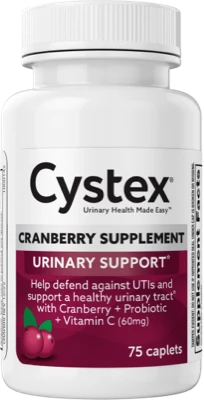Did You Experience a UTI this Year? You’re in Good Company
Urinary tract infections (UTIs) are one of the most common infections in the United States. More than half of all women will experience one in their lifetimes. Fortunately, commonsense strategies can help prevent this very common ailment.
As we wind down the year, many of us find ourselves reflecting on the highs and lows of the past 12 months and setting goals for the future.
Did you experience a urinary tract infection (UTI) this year? Or, worse, recurring UTIs? If so, you’re certainly NOT the only one.
According to the National Institutes of Health:
- UTIs are the second most common type of infection in the body (second only to pneumonia).
- There are 8.1 million visits to healthcare providers each year because of UTIs.
- More than 50% of all women and 12% of men will experience a symptomatic UTI in their lifetimes.
- 20% of young women who experience a UTI will get another one.
- With every UTI contracted, risk of recurrence increases.
- Some women have three or more UTIs per year.
- Thankfully, however, very few women will have frequent infections their whole lives. It’s common for a woman to have a period of 1 or 2 years with frequent infections, after which recurring infections cease.1,2
Yup, the painful and annoying burning frequency of a UTI is very common.
Fortunately, there are practical ways to help prevent UTIs and take care of them when they do occur.
How about making it a goal to incorporate these prevention and urinary health strategies into your life starting now? Why wait?
- Always wipe front to back after toileting.3
- Urinate before and after sexual activities.4
- Drink more water.3
- Drink less caffeine and alcohol.4
- If you suffer from recurring UTIs, talk to your healthcare provider about changing your birth control method, especially if you use a diaphragm, unlubricated condoms, or spermicidal lubricated condoms.5
- Pee every 4 hours or whenever you feel the urge and empty your bladder each time.3
- Gently cleanse your private parts daily in a shower, not a bath.3
- Use tampons not pads for periods.3
- Avoid scented feminine and bath products like douches, powders, sprays, bubbles, salts, and oils.4
- Wear clean cotton underwear or underwear with a cotton crotch panel.3,4
- Avoid tight pants and change out of damp bottoms promptly.3
- Try Cystex Urinary Health Maintenance to help maintain your urinary health. Ingredients include a prebiotic to help promote healthy bacteria, an anti-inflammatory to help to prevent tissue damage, an anti-adherent to help keep bad bacteria from hanging around, and an anti-oxidant to generally help protect your body.
If you experience UTI symptoms like a frequent urge to urinate, a burning feeling while urinating, cloudy or strong smelling urine, or pelvic pain; contact your doctor right away. The only cure for a UTI is a prescription antibiotic.
Waiting for your appointment or medicine? Try an over-the-counter product like Cystex® Plus Urinary Pain Relief Tablets to help relieve the pain associated with a UTI and keep the infection in check in the interim.
We’ve gotten those resolutions out of the way early!
Now, who’s ready to get ahead on holiday shopping, too?
References:
- Urinary Tract Infections in Adults. National Institute of Diabetes and Digestive and Kidney Diseases website https://www.niddk.nih.gov/health-information/health-topics/urologic-disease/urinary-tract-infections-in-adults/Pages/facts.aspx. Accessed November 15, 2016.
- How Many Women are Affected or At Risk for UTIs & UI? Eunice Kennedy Shriver National Institute of Child Health and Human Development website https://www.nichd.nih.gov/health/topics/urinary/conditioninfo. Accessed November 15, 2016.
- Prevention of Urinary Tract Infections in Women. Medscape website. http://emedicine.medscape.com/article/1958794-overview. Accessed August 9, 2016.
- Urinary Tract Infection in Women – Self-Care. U.S. National Library of Medicine/MedlinePlus website https://medlineplus.gov/ency/patientinstructions/000391.htm. Accessed August 9, 2016
- Your Guide to Urinary Tract Infections (UTIs); How to Prevent Re-Infection. WebMD website http://www.webmd.com/women/guide/your-guide-urinary-tract-infections?page=3. Accessed August 8, 2016.








